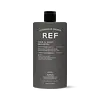What's inside
What's inside
 Key Ingredients
Key Ingredients

 Benefits
Benefits

 Concerns
Concerns

 Ingredients Side-by-side
Ingredients Side-by-side

Water
Skin ConditioningCocamidopropyl Hydroxysultaine
CleansingCocamidopropyl Betaine
CleansingCoco-Glucoside
CleansingPEG-120 Methyl Glucose Dioleate
EmulsifyingCocamidopropylamine Oxide
CleansingPEG-40 Hydrogenated Castor Oil
EmulsifyingParfum
MaskingPolyquaternium-10
Imidazolidinyl Urea
PreservativeUrea
BufferingPropylene Glycol
HumectantPanthenol
Skin ConditioningPolyquaternium-22
Limonene
PerfumingHydrolyzed Quinoa
Skin ConditioningArnica Montana Extract
Skin ConditioningChamomilla Recutita Extract
Skin ConditioningPrunus Amygdalus Dulcis Oil
Skin ConditioningButylene Glycol
HumectantQuaternium-95
UV AbsorberHelianthus Annuus Seed Extract
Skin ConditioningPropanediol
SolventMethylchloroisothiazolinone
PreservativeCI 47005
Cosmetic ColorantCI 19140
Cosmetic ColorantCI 42051
Cosmetic ColorantMethylisothiazolinone
PreservativeWater, Cocamidopropyl Hydroxysultaine, Cocamidopropyl Betaine, Coco-Glucoside, PEG-120 Methyl Glucose Dioleate, Cocamidopropylamine Oxide, PEG-40 Hydrogenated Castor Oil, Parfum, Polyquaternium-10, Imidazolidinyl Urea, Urea, Propylene Glycol, Panthenol, Polyquaternium-22, Limonene, Hydrolyzed Quinoa, Arnica Montana Extract, Chamomilla Recutita Extract, Prunus Amygdalus Dulcis Oil, Butylene Glycol, Quaternium-95, Helianthus Annuus Seed Extract, Propanediol, Methylchloroisothiazolinone, CI 47005, CI 19140, CI 42051, Methylisothiazolinone
Water
Skin ConditioningSodium Laureth Sulfate
CleansingCocamidopropyl Betaine
CleansingSodium Lauroyl Sarcosinate
CleansingPEG-40 Hydrogenated Castor Oil
EmulsifyingGlycol Distearate
EmollientPhenoxyethanol
PreservativeSodium Benzoate
MaskingC12-13 Alkyl Lactate
EmollientLactic Acid
BufferingLaureth-4
EmulsifyingBetaine
HumectantMentha Arvensis Herb Oil
PerfumingGuar Hydroxypropyltrimonium Chloride
Skin ConditioningMelaleuca Alternifolia Leaf Oil
AntioxidantFormic Acid
PreservativeTetrasodium EDTA
Benzoic Acid
MaskingSodium Chloride
MaskingDehydroacetic Acid
PreservativeParfum
MaskingWater, Sodium Laureth Sulfate, Cocamidopropyl Betaine, Sodium Lauroyl Sarcosinate, PEG-40 Hydrogenated Castor Oil, Glycol Distearate, Phenoxyethanol, Sodium Benzoate, C12-13 Alkyl Lactate, Lactic Acid, Laureth-4, Betaine, Mentha Arvensis Herb Oil, Guar Hydroxypropyltrimonium Chloride, Melaleuca Alternifolia Leaf Oil, Formic Acid, Tetrasodium EDTA, Benzoic Acid, Sodium Chloride, Dehydroacetic Acid, Parfum
Ingredients Explained
These ingredients are found in both products.
Ingredients higher up in an ingredient list are typically present in a larger amount.
Cocamidopropyl Betaine is a fatty acid created by mixing similar compounds in coconut oil and dimethylaminopropylamine, a compound with two amino groups.
This ingredient is a surfactant and cleanser. It helps gather the dirt, pollutants, and other impurities in your skin to be washed away. It also helps thicken a product and make the texture more creamy.
Being created from coconut oil means Cocamidopropyl Betaine is hydrating for the skin.
While Cocamidopropyl Betaine was believed to be an allergen, a study from 2012 disproved this. It found two compounds in unpure Cocamidopropyl Betaine to be the irritants: aminoamide and 3-dimethylaminopropylamine. High-grade and pure Cocamidopropyl Betaine did not induce allergic reactions during this study.
Learn more about Cocamidopropyl BetaineParfum is a catch-all term for an ingredient or more that is used to give a scent to products.
Also called "fragrance", this ingredient can be a blend of hundreds of chemicals or plant oils. This means every product with "fragrance" or "parfum" in the ingredients list is a different mixture.
For instance, Habanolide is a proprietary trade name for a specific aroma chemical. When used as a fragrance ingredient in cosmetics, most aroma chemicals fall under the broad labeling category of “FRAGRANCE” or “PARFUM” according to EU and US regulations.
The term 'parfum' or 'fragrance' is not regulated in many countries. In many cases, it is up to the brand to define this term.
For instance, many brands choose to label themselves as "fragrance-free" because they are not using synthetic fragrances. However, their products may still contain ingredients such as essential oils that are considered a fragrance by INCI standards.
One example is Calendula flower extract. Calendula is an essential oil that still imparts a scent or 'fragrance'.
Depending on the blend, the ingredients in the mixture can cause allergies and sensitivities on the skin. Some ingredients that are known EU allergens include linalool and citronellol.
Parfum can also be used to mask or cover an unpleasant scent.
The bottom line is: not all fragrances/parfum/ingredients are created equally. If you are worried about fragrances, we recommend taking a closer look at an ingredient. And of course, we always recommend speaking with a professional.
Learn more about ParfumPeg-40 Hydrogenated Castor Oil is derived from castor oil and polyethylene glycol (PEG). It is used as a emollient and emulsifier.
As an emulsifier, it helps prevent ingredients from separating. It also helps make the other ingredients more soluble; it is often used to solubilize fragrances. This increases spreadability and elongates shelf life in a product.
Emollients help soothe and soften the skin. They do this by creating a protective film on your skin. This barrier helps trap moisture and keeps your skin hydrated. Emollients may be effective at treating dry or itchy skin.
This ingredient may or may not be vegan, depending on the source.
Peg-40 Hydrogenated Castor Oil may not be fungal-acne safe. We recommend speaking with a professional if you have any questions or concerns.
Learn more about PEG-40 Hydrogenated Castor OilWater. It's the most common cosmetic ingredient of all. You'll usually see it at the top of ingredient lists, meaning that it makes up the largest part of the product.
So why is it so popular? Water most often acts as a solvent - this means that it helps dissolve other ingredients into the formulation.
You'll also recognize water as that liquid we all need to stay alive. If you see this, drink a glass of water. Stay hydrated!
Learn more about Water